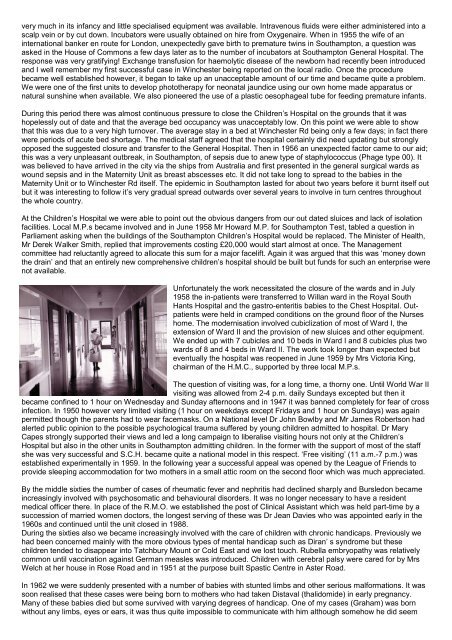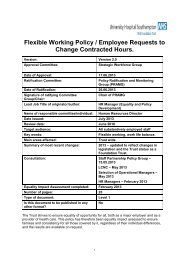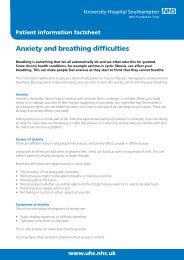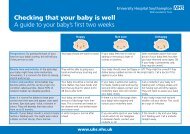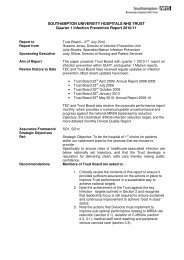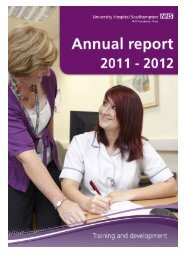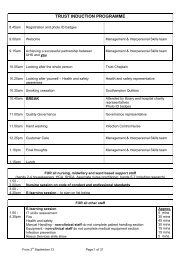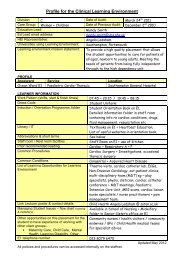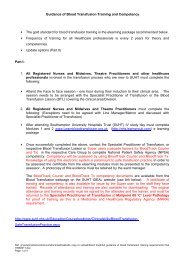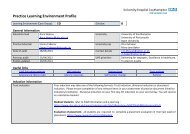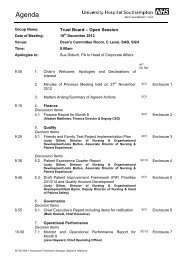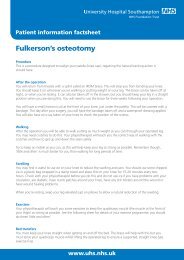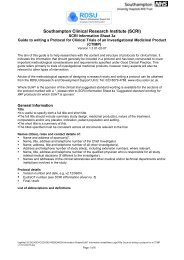ninety years of service - University Hospital Southampton NHS ...
ninety years of service - University Hospital Southampton NHS ...
ninety years of service - University Hospital Southampton NHS ...
- No tags were found...
Create successful ePaper yourself
Turn your PDF publications into a flip-book with our unique Google optimized e-Paper software.
very much in its infancy and little specialised equipment was available. Intravenous fluids were either administered into ascalp vein or by cut down. Incubators were usually obtained on hire from Oxygenaire. When in 1955 the wife <strong>of</strong> aninternational banker en route for London, unexpectedly gave birth to premature twins in <strong>Southampton</strong>, a question wasasked in the House <strong>of</strong> Commons a few days later as to the number <strong>of</strong> incubators at <strong>Southampton</strong> General <strong>Hospital</strong>. Theresponse was very gratifying! Exchange transfusion for haemolytic disease <strong>of</strong> the newborn had recently been introducedand I well remember my first successful case in Winchester being reported on the local radio. Once the procedurebecame well established however, it began to take up an unacceptable amount <strong>of</strong> our time and became quite a problem.We were one <strong>of</strong> the first units to develop phototherapy for neonatal jaundice using our own home made apparatus ornatural sunshine when available. We also pioneered the use <strong>of</strong> a plastic oesophageal tube for feeding premature infants.During this period there was almost continuous pressure to close the Children’s <strong>Hospital</strong> on the grounds that it washopelessly out <strong>of</strong> date and that the average bed occupancy was unacceptably low. On this point we were able to showthat this was due to a very high turnover. The average stay in a bed at Winchester Rd being only a few days; in fact therewere periods <strong>of</strong> acute bed shortage. The medical staff agreed that the hospital certainly did need updating but stronglyopposed the suggested closure and transfer to the General <strong>Hospital</strong>. Then in 1956 an unexpected factor came to our aid;this was a very unpleasant outbreak, in <strong>Southampton</strong>, <strong>of</strong> sepsis due to anew type <strong>of</strong> staphylococcus (Phage type 00). Itwas believed to have arrived in the city via the ships from Australia and first presented in the general surgical wards aswound sepsis and in the Maternity Unit as breast abscesses etc. It did not take long to spread to the babies in theMaternity Unit or to Winchester Rd itself. The epidemic in <strong>Southampton</strong> lasted for about two <strong>years</strong> before it burnt itself outbut it was interesting to follow it’s very gradual spread outwards over several <strong>years</strong> to involve in turn centres throughoutthe whole country.At the Children’s <strong>Hospital</strong> we were able to point out the obvious dangers from our out dated sluices and lack <strong>of</strong> isolationfacilities. Local M.P.s became involved and in June 1958 Mr Howard M.P. for <strong>Southampton</strong> Test, tabled a question inParliament asking when the buildings <strong>of</strong> the <strong>Southampton</strong> Children’s <strong>Hospital</strong> would be replaced. The Minister <strong>of</strong> Health,Mr Derek Walker Smith, replied that improvements costing £20,000 would start almost at once. The Managementcommittee had reluctantly agreed to allocate this sum for a major facelift. Again it was argued that this was ‘money downthe drain’ and that an entirely new comprehensive children’s hospital should be built but funds for such an enterprise werenot available.Unfortunately the work necessitated the closure <strong>of</strong> the wards and in July1958 the in-patients were transferred to Willan ward in the Royal SouthHants <strong>Hospital</strong> and the gastro-enteritis babies to the Chest <strong>Hospital</strong>. Outpatientswere held in cramped conditions on the ground floor <strong>of</strong> the Nurseshome. The modernisation involved cubiclization <strong>of</strong> most <strong>of</strong> Ward I, theextension <strong>of</strong> Ward II and the provision <strong>of</strong> new sluices and other equipment.We ended up with 7 cubicles and 10 beds in Ward I and 8 cubicles plus twowards <strong>of</strong> 8 and 4 beds in Ward II. The work took longer than expected buteventually the hospital was reopened in June 1959 by Mrs Victoria King,chairman <strong>of</strong> the H.M.C., supported by three local M.P.s.The question <strong>of</strong> visiting was, for a long time, a thorny one. Until World War IIvisiting was allowed from 2-4 p.m. daily Sundays excepted but then itbecame confined to 1 hour on Wednesday and Sunday afternoons and in 1947 it was banned completely for fear <strong>of</strong> crossinfection. In 1950 however very limited visiting (1 hour on weekdays except Fridays and 1 hour on Sundays) was againpermitted though the parents had to wear facemasks. On a National level Dr John Bowlby and Mr James Robertson hadalerted public opinion to the possible psychological trauma suffered by young children admitted to hospital. Dr MaryCapes strongly supported their views and led a long campaign to liberalise visiting hours not only at the Children’s<strong>Hospital</strong> but also in the other units in <strong>Southampton</strong> admitting children. In the former with the support <strong>of</strong> most <strong>of</strong> the staffshe was very successful and S.C.H. became quite a national model in this respect. ‘Free visiting’ (11 a.m.-7 p.m.) wasestablished experimentally in 1959. In the following year a successful appeal was opened by the League <strong>of</strong> Friends toprovide sleeping accommodation for two mothers in a small attic room on the second floor which was much appreciated.By the middle sixties the number <strong>of</strong> cases <strong>of</strong> rheumatic fever and nephritis had declined sharply and Bursledon becameincreasingly involved with psychosomatic and behavioural disorders. It was no longer necessary to have a residentmedical <strong>of</strong>ficer there. In place <strong>of</strong> the R.M.O. we established the post <strong>of</strong> Clinical Assistant which was held part-time by asuccession <strong>of</strong> married women doctors, the longest serving <strong>of</strong> these was Dr Jean Davies who was appointed early in the1960s and continued until the unit closed in 1988.During the sixties also we became increasingly involved with the care <strong>of</strong> children with chronic handicaps. Previously wehad been concerned mainly with the more obvious types <strong>of</strong> mental handicap such as Diran’ s syndrome but thesechildren tended to disappear into Tatchbury Mount or Cold East and we lost touch. Rubella embryopathy was relativelycommon until vaccination against German measles was introduced. Children with cerebral palsy were cared for by MrsWelch at her house in Rose Road and in 1951 at the purpose built Spastic Centre in Aster Road.In 1962 we were suddenly presented with a number <strong>of</strong> babies with stunted limbs and other serious malformations. It wassoon realised that these cases were being born to mothers who had taken Distaval (thalidomide) in early pregnancy.Many <strong>of</strong> these babies died but some survived with varying degrees <strong>of</strong> handicap. One <strong>of</strong> my cases (Graham) was bornwithout any limbs, eyes or ears, it was thus quite impossible to communicate with him although somehow he did seem


